![]()
![]()
![]()
Use LEFT and RIGHT arrow keys to navigate between flashcards;
Use UP and DOWN arrow keys to flip the card;
H to show hint;
A reads text to speech;
29 Cards in this Set
- Front
- Back
- 3rd side (hint)
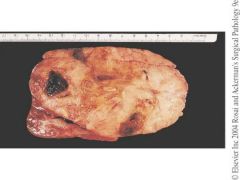
pediatric
|
Wilm's Tumor (Nephroblastoma)
unicentric mass, unilateral, round, sharply demarcated, whorled appearance, may be cystic or hemorrhagic |
85% of pediatric renal tumors
asians > whites > blacks, 40 months presentation: palpable mass, hematuria, HTN, flank pain associated w/ other congenital syndromes (Aniridia-Genital anomalies, Denys-Drash (intersex, glomerulopathy), Beckwith-Wiedmann Syndrome(hemihypertrophy, gigantism)) Genetics: 11p WT1/2 transcription factors Tx: surgical removal + adjuvant chemo (good prognosis) |
|
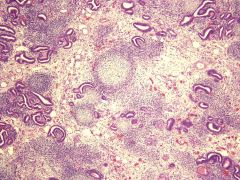
|
Wilms Tumors (Nephroblastoma)
Triphasic (blastema, stroma, epithelia), bone and cartilage often seen |
85% of pediatric renal tumors
asians > whites > blacks, 40 months presentation: palpable mass, hematuria, HTN, flank pain associated w/ other congenital syndromes (Aniridia-Genital anomalies, Denys-Drash (intersex, glomerulopathy), Beckwith-Wiedmann Syndrome(hemihypertrophy, gigantism)) Genetics: 11p WT1/2 transcription factors Tx: surgical removal + adjuvant chemo (good prognosis) |
|
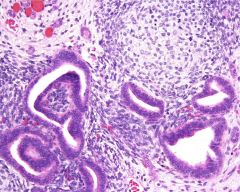
|
Wilms Tumors (Nephroblastoma)
Triphasic (blastema, stroma, epithelia), bone and cartilage often seen |
85% of pediatric renal tumors
asians > whites > blacks, 40 months presentation: palpable mass, hematuria, HTN, flank pain associated w/ other congenital syndromes (Aniridia-Genital anomalies, Denys-Drash (intersex, glomerulopathy), Beckwith-Wiedmann Syndrome(hemihypertrophy, gigantism)) Genetics: 11p WT1/2 transcription factors Tx: surgical removal + adjuvant chemo (good prognosis) |
|
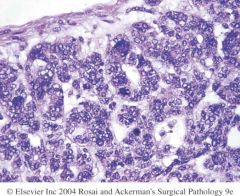
|
Wilms Tumor (Nephroblastoma)
anaplastic variant - worse prognosis abnormal mitosis, nuclear enlargement and hyperchromasia |
85% of pediatric renal tumors
asians > whites > blacks, 40 months presentation: palpable mass, hematuria, HTN, flank pain associated w/ other congenital syndromes (Aniridia-Genital anomalies, Denys-Drash (intersex, glomerulopathy), Beckwith-Wiedmann Syndrome(hemihypertrophy, gigantism)) Genetics: 11p WT1/2 transcription factors Tx: surgical removal + adjuvant chemo (good prognosis) |
|
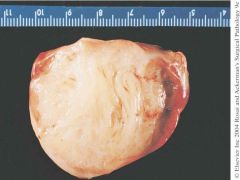
|
Congenital Mesoblastic Nephroma
1-14 cm solitary tan mass, cutic degeneration and sharp demarcation but not ecapsulated, may be hemorrhagic |
5% pediatric renal tumors
low grade fibroblastic sarcoma presents: palpable mass before 6 mon or inutero w/ US associated w/ polyhydramnios, hydrops, maternal hyperCa genetics: t(12;15) ETV6-NTRK3 fusion gene --> membrane protein w/ tyrosine kinase activity Tx w/ complete excision + adjuvant chemo if some tumor remains |
|

|
Congenital Mesoblastic Nephroma
spindle cells, low mitotic activity, interlacing fascicles, variants show aggressive behavior |
5% pediatric renal tumors
low grade fibroblastic sarcoma presents: palpable mass before 6 mon or inutero w/ US associated w/ polyhydramnios, hydrops, maternal hyperCa genetics: t(12;15) ETV6-NTRK3 fusion gene --> membrane protein w/ tyrosine kinase activity Tx w/ complete excision + adjuvant chemo if some tumor remains |
|
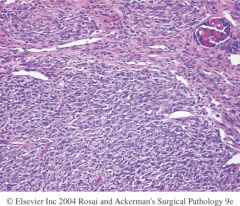
|
Congenital Mesoblastic Nephroma
spindle cells, low mitotic activity, interlacing fascicles, variants show aggressive behavior |
5% pediatric renal tumors
low grade fibroblastic sarcoma presents: palpable mass before 6 mon or inutero w/ US associated w/ polyhydramnios, hydrops, maternal hyperCa genetics: t(12;15) ETV6-NTRK3 fusion gene --> membrane protein w/ tyrosine kinase activity Tx w/ complete excision + adjuvant chemo if some tumor remains |
|
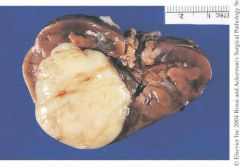
|
clear cell carcinoma
large, not encapsulated but well circumsribed, mucoid, focally cystic |
"bone metastasizing tumor"
4% of childhood renal tumors presents at 2 yrs of age M>F genetics: t(10;17) cells express vimentin & bcl2 highly malignant w/ skeletal mets tx: surgery & chemo, 65% survival |
|
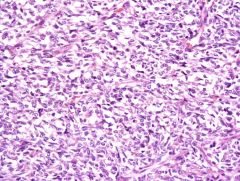
|
Clear Cell Sarcoma
epithelioid cells in cords and nests, ovoid w/ fine chromatin, myoid stroma mimics "clear" cytoplasm |
"bone metastasizing tumor"
4% of childhood renal tumors presents at 2 yrs of age M>F genetics: t(10;17) cells express vimentin & bcl2 highly malignant w/ skeletal mets tx: surgery & chemo, 65% survival |
|
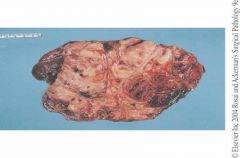
|
Rhabdoid tumor
soft, tan, areas of necrosis/hemorrhage, invasive border, satellite tumors |
2.5% pediatric renal tumors
presents: 11mo (95%<3 y/o) genetics: 22p deletion affects histone complex configuration --> acts like mutated tumor suppressor gene |
|
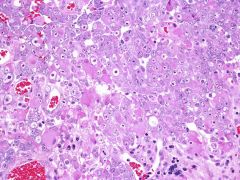
|
Rhabdoid Tumor
broad sheets, loosely coherent, abundant eosinophilc cytoplasm, whorled filaments |
2.5% pediatric renal tumors
presents: 11mo (95%<3 y/o) genetics: 22p deletion affects histone complex configuration --> acts like mutated tumor suppressor gene poor outcomes (80% mortality) |
|
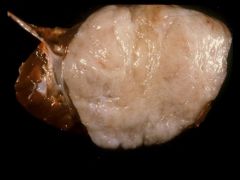
|
Metanephric adenoma
well circumscribed but not encapsulated, cysts may be present, hemorrhage and calcification may be present |
benign, occurs in adults and children
F>M, 40% incidental finding PV association, may have mass or flank pain genetics: trisomy 7 & 17, loss of Y or X WT1 and CD57 expressed (differentiate from Wilms) tx: excision is curative |
|
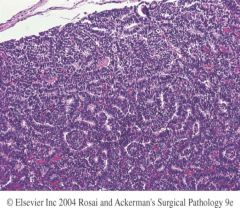
|
Metanephric Adenoma
cells form tight round acini, branching tubular structures, calcifications and papillary structures may be present. DO NOT CONFUSE W/ MALIGNANT |
benign, occurs in adults and children
F>M, 40% incidental finding PV association, may have mass or flank pain genetics: trisomy 7 & 17, loss of Y or X WT1 and CD57 expressed (differentiate from Wilms) tx: excision is curative |
|
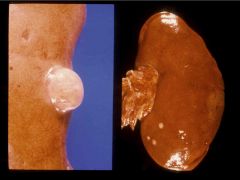
|
Papillary Renal Cell Adenoma
small tumors, well circumscribed but not encapsulated, solitary |
most common renal cortical tumor
incidental finding 37% of pts >60 y/o asymptomatic genetics: loss of Y, trisomy 7 & 17 incr rate in pts on long term dialysis |
|
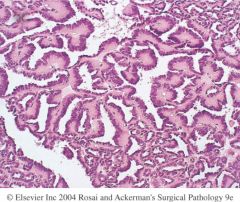
|
Papillary Renal Cell Adenoma
papillary or tubulopapillary architecture, chromatin clumping |
most common renal cortical tumor
incidental finding 37% of pts >60 y/o asymptomatic genetics: loss of Y, trisomy 7 & 17 incr rate in pts on long term dialysis |
|

|
renal oncocytoma
well circumscribed nonencapsulated, cnetral stellate scar on imaging when large, hemorrhage in 20% |
benign neoplasm w/ histo overlap w/ RCC
5% of all renal tumors, M>F, all ages seen on X-ray (stellate) typically asymptomatic tx w/ excision |
|

|
Renal Oncocytoma
sheets and nests of polygonal cells w/ abundant eosinophilc cytoplasm and prominent nucleoli, form acinia, tubules, microcysts |
benign neoplasm w/ histo overlap w/ RCC
5% of all renal tumors, M>F, all ages seen on X-ray (stellate) typically asymptomatic tx w/ excision |
|
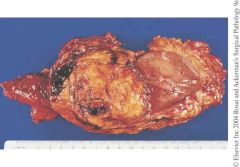
|
Angiomyolipoma
well demarcated, color varies |
benign neoplasm of perivascular epithelioid stem cells
express melanocytic and SMC markers incr frequency in tuberous sclerosis pts 4:1 female predominance, 45 y/o mean age presents: asymptomatic, flank pain, retroperitoneal hemorrhage, lymphangioleiomyomatosis of lung association genes coding for tuberin and hamartin may cause life threatening hemorrhage, M&M related to tumor size and soociated lesions TS complex Tx: surgical excision |
|
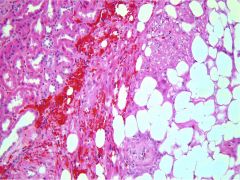
|
Angiomyolipoma
three elements - adipocytes, small muscular arteries, SMC |
benign neoplasm of perivascular epithelioid stem cells
express melanocytic and SMC markers incr frequency in tuberous sclerosis pts 4:1 female predominance, 45 y/o mean age presents: asymptomatic, flank pain, retroperitoneal hemorrhage, lymphangioleiomyomatosis of lung association genes coding for tuberin and hamartin may cause life threatening hemorrhage, M&M related to tumor size and soociated lesions TS complex Tx: surgical excision |
|
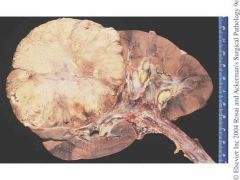
|
malignant gross
solitary mass, upper or lower pole, well demarcated, hemorrhage and cystic degeneration |
RCC 90% of malignant kidney tumors in adults (clear cell 75%, papillary 15%, chromophobe 5%, medullary associated w/ sickle cell)
presents: hematuria, flank pain, palpable mass, anorexia, weight loss, fever, paraneoplastic causal: smoking, arsenic, cadmium, obesity, hydrocarbons (pesiticide) |
|
|
adult tumor malignant genetics
(clear cell, papillary, chromophobe) |
CC - 3p deletion, VHL gene, dysregulation of HIF
Papillary Carcinoma - trisomy 7 & 17 Chromophobe carcinoma - LOH at 3p, 5q, 17p, isolated loss of chromosomes 1,2,6,10,13,17,21 Xq11.2 translocation tumors - TFE3 (DNA transcription gene) fusion gene |
|
|
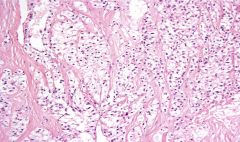
|
Clear Cell Grade 1
|
70-80%
50% confined, 50% invasive vimentin & keratin positive arises from proximal or distal tubule genetics t(3;8) 50% 5 yr survival |
|
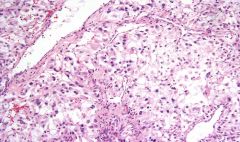
|
clear cell carcinoma grade 2
|
70-80%
50% confined, 50% invasive vimentin & keratin positive arises from proximal or distal tubule genetics t(3;8) 50% 5 yr survival |
|
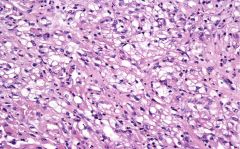
|
clear cell carcinoma grade 3
|
70-80%
50% confined, 50% invasive vimentin & keratin positive arises from proximal or distal tubule genetics t(3;8) 50% 5 yr survival |
|
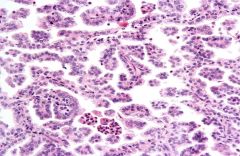
|
Papillary carcinoma type 1
|
second most common renal cell carcinoma 10-15%
type 1 - 65% of cases, papillary and tubular structures, small cells w/ pale cytoplasm, foamy macrophages type 2 - papillae lined by large cells with abundant eosinophilc cytoplasm, younger pts presents similar to clear cell trisomy of 7 & 17 |
|
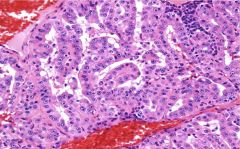
|
papillary carcinoma type 2
|
second most common renal cell carcinoma 10-15%
type 1 - 65% of cases, papillary and tubular structures, small cells w/ pale cytoplasm, foamy macrophages type 2 - papillae lined by large cells with abundant eosinophilc cytoplasm, younger pts presents similar to clear cell trisomy of 7 & 17 |
|
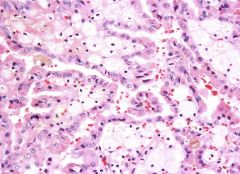
|
papillary carcinoma and foam cells
|
second most common renal cell carcinoma 10-15%
type 1 - 65% of cases, papillary and tubular structures, small cells w/ pale cytoplasm, foamy macrophages type 2 - papillae lined by large cells with abundant eosinophilc cytoplasm, younger pts presents similar to clear cell trisomy of 7 & 17 |
|
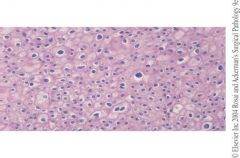
|
chromophobe carcinoma
|
2-7% of parenchymal malignancies
presentation similar to other malignant tumors faborale prognosis |
|
|
Malignant Adult Tumors errata
|
sicle cell - medullary carcinoma
mesenchymal sarcomas in the kidney lymphomas in the kidney transitional cell carcinoma of pelvis (smoking, acts like bladder tumor, environmental exposure, NSAID abuse) |
|

